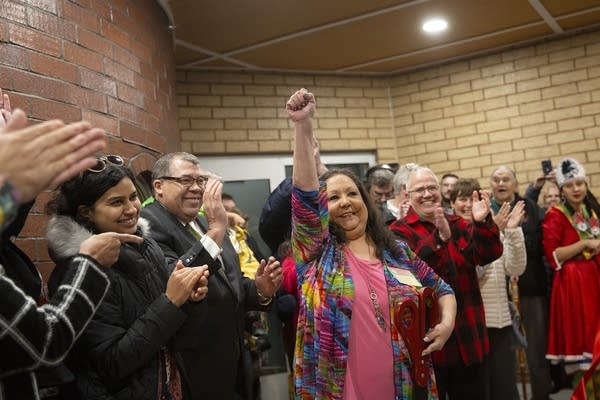A ‘good new home’ welcomes the formerly homeless
Mino Oski Ain Dah Yung offers housing and culturally relevant support for Native American young adults

Go Deeper.
Create an account or log in to save stories.
Like this?
Thanks for liking this story! We have added it to a list of your favorite stories.
A new 42-unit housing project opened recently in St. Paul that focuses on helping homeless Native American young adults. It’s called Mino Oski Ain Dah Yung, which means “good new home” in Ojibwe.
It will provide residents with housing and help them with education and employment — all while helping them celebrate their culture.
The $13.6 million project on University Avenue near Dale Street was conceived, designed and built by Native Americans. Images of teepees and animals of spiritual and teaching significance adorn the facade of the four-story building.
Inside, each floor is designed with the eagle, buffalo or other teaching animal in mind. There are computer and job training rooms — and spaces where residents can make drums and native clothing.
Turn Up Your Support
MPR News helps you turn down the noise and build shared understanding. Turn up your support for this public resource and keep trusted journalism accessible to all.
More than 100 people attended the building's grand opening last month. Deb Foster, executive director of the nonprofit Ain Dah Yung Center, told guests that homelessness and other challenges in the state are experienced disproportionately by Native Americans.
"This building is so needed,” Foster said.
Ain Dah Yung Center has operated an emergency shelter for runaway and homeless American Indian youth for 36 years. Now, with the opening of the University Avenue building, the organization has permanent housing for dozens of people from ages 18 to 24. Residents will pay 30 percent of their income toward rent.
“Every aspect of this building and the success of this project for our young people will be due to the fact it was Native-led and grounded in American Indian culture and traditions,” Foster said.
Homelessness is an extremely serious problem for Native Americans in Minnesota. In a 2018 Minnesota Homeless Study conducted by Wilder research, 12 percent of homeless people interviewed identified as American Indian. But Native Americans account for just about 1 percent of Minnesotans. A 2015 statewide study found that about a tenth of homeless people 24 years of age or younger are American Indian.
Last winter, a temporary shelter known as the navigation center was built to house nearly 200 people from a predominantly Native American homeless encampment along Franklin and Hiawatha avenues.
The Ain Dah Yung Center partnered with Minneapolis-based Project for Pride in Living to get the small studio apartments built. The nonprofit developer and manager of affordable housing provided financial and other expertise and will co-own the building.
"Where we have our biggest gap — in terms of the need for homeless units — is actually for homeless youth,” said PPL CEO Paul Williams. “So, this is a tremendous resource to help fill that gap."

Foster said Mino Oski Ain Dah Yung represents a unique approach to the challenge.
“This is a one of a kind that is built and designed specifically around healing, with the cultural activities center, the medicine gardens where kids will be able to plant and harvest medicines. We'll have a sweat lodge,” she said.
The grand opening last month was a blessed event. A prayer was offered for the building and the young people who will call it home. Architect Mike Laverdure, an enrolled member of the Turtle Mountain Band of Chippewa Indians, designed the building.
"I believe this building is actually a living thing,” he said. “It's like an elder coddling and helping heal these youth who are off the street now and in this home."
Shataye Hune moved in a little less than a month ago, after four years of homelessness. The 19-year-old spent a lot of time shelter-hopping and sleeping on MetroTransit busses and trains.

“Four years is really tough,” she said. “Being 15,16,17 before I hit adulthood. It was very challenging. To be in a program like this is just a blessing."
Now, Hune, who is African-American and Ojibwe, has a small studio apartment of her own with a private bath and kitchen. And she is getting help from Ain Dah Yung staff and others with renewing her education and the rest of her life.
“They're giving kids and young adults the support that they need to come off the streets and actually go into adulthood and be successful,” she said.
Hundreds more units of housing are desperately needed for homeless youth, said James Scott, a senior training manager with StreetWorks. That's a collaborative of nonprofits that help homeless youth. But Scott said addressing homelessness takes more than just putting a roof over someone's head and providing meals.
"Most people — to get through homelessness or exploitation — need community,” he said. “They need their culture. They need their people."
And that's who residents of Mino Oski Ain Dah Yung find around them.




